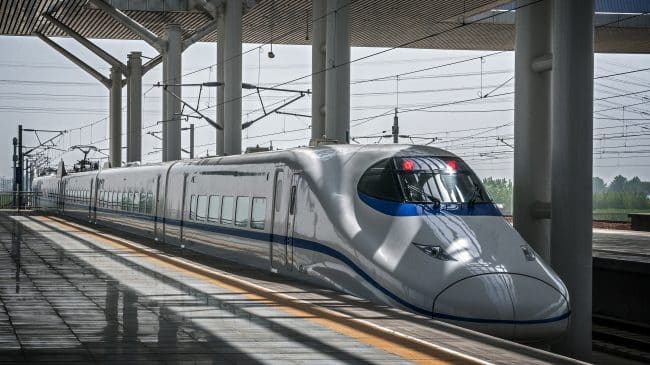The recent NBA-China dispute brought some of the obvious free speech, political and economic differences between the two countries to the forefront. These differences are why it is so odd that some advocates of high-speed rail wistfully cite China’s high-speed rail system as a possible template for trains in California and the United States.
“You go to China, they have trains that go 300 miles an hour. We have trains that go ‘chug, chug, chug.’ And then they have to stop because the tracks split, right?” said then-presidential candidate Donald Trump during a 2016 presidential debate. “They have trains that go 300 miles an hour…We are like third world.”
China has built almost 30,000 kilometers of high-speed rail lines since the beginning of the century, while the US has completed virtually none. While some may find it tempting to think that the US could somehow replicate China’s rail system, doing so would require a vastly different approach to government spending, property rights, and workers’ rights that Americans would, and should, be unwilling to take.
China does not have the equivalent of America’s constitutional “takings” clause which states that “private property [shall not] be taken for public use, without just compensation.” The Chinese government is thought to have seized over 10 million acres of private land between 2004 and 2014, often with little or no notice and minimal compensation. In a recent case, Chinese officials ordered a house bulldozed without warning the owners, killing a 60-year old villager whose body was found in the debris three weeks later.
In California, the terms of engagement with property owners are rightfully more respectful and typically follow the rule of law. The California High-Speed Rail Authority (CHSRA) has identified 1,830 parcels that must be acquired to build its 119-mile initial operating segment alone. As of May 2019, 304 of these were still pending years after the project started. And CHSRA has already spent over $1.13 billion buying properties. But a significant chunk of this money is not going to property owners and the costs highlight the type of problems that have plagued the high-speed rail project.
CHSRA has awarded contracts totaling about $64 million to seven companies that provide “right-of-way and real estate services.” Invoices from one of these firms, Associated Right of Way Services (ARWS), appears to be the subject of a federal Department of Transportation audit.
According to documents Reason received in connection with a Freedom of Information Act request, ARWS personnel bill the state at rates of up to $250 per hour. One ARWS invoice included $5,142 in charges related to acquiring a parcel occupied by a Wasco tire store. Charges included $1,125 for the project manager to review timesheets and invoices and to prepare meeting notes. Since only one month of billing details were available, we don’t yet know the full cost of AWRS’s services for acquiring this 0.88-acre property.
Real estate contractors are not the only well-compensated employees on the high-speed rail project. State employees working for the California High-Speed Rail Authority had a median salary of $76,000 and median benefits of $35,000 in 2018. Most of the people working on the California rail project are not directly employed by the state, but by construction contractors. These unionized employees are covered by state prevailing wage laws, which determine salary and benefits. For example, a concrete mixer operator in Fresno receives basic pay of $39 per hour, full pension and health benefits, and time-and-a-half for overtime hours.
Needless to say, labor conditions in China are quite different. The nation relies on migrant workers whose monthly salaries average about $600. Independent labor unions are illegal and working conditions are often poor. Although most employers carry insurance for worksite injuries, payments in the event of an accident can be spotty at best and most workers do not receive medical insurance.
The California high-speed rail project has failed to deliver what it promised to voters over a decade ago. Undoubtedly, the construction of California’s high-speed rail could have been faster and cheaper had there been better planning, management, and perhaps even a more supportive political environment.
But the yearning for something like China’s rail system should stop. Given the rule of law, the need to protect property and defend workers’ rights, high-speed rail projects in the United States will never achieve the ruthless efficiency of those in China. And that’s a good thing.
This column originally appeared in the Orange County Register.

